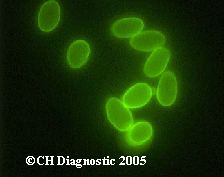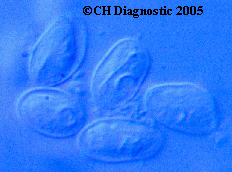Giardia spp. Information
 Giardia lamblia is a
pathogenic protozoan with a size range of 8-18 um long and 5-15 um
wide that reproduces in the intestinal tract of mammals. In the final stage of
its life cycle, Giardia asexually produces environmentally resistant
structures known as cysts, and these are shed within animal feces and can
contaminant food and water sources. In humans, infection may result in acute
gastrointestinal distresses including diarrhea, weight loss, vomiting, or
fatigue; however, certain individuals may not manifest symptoms but otherwise
remain infected. These asymptomatic carriers can for many years potentially
transmit infection to others. Many mammalian reservoir hosts, including dogs,
cats, beavers and muskrats, can carry the parasite. These hosts readily shed
cysts within their feces which may contaminate the watershed. Giardia
is common in surface waters and generally, for potable water, cysts are
removed by filtration and/or inactivated by chlorine disinfection. However, if
filtration is deficient or water is not properly treated, cysts can be present
in finished drinking water and may be ingested by humans causing
gastroenteritis of varying severity. Several waterborne outbreaks have been
attributed to Giardia.
Giardia lamblia is a
pathogenic protozoan with a size range of 8-18 um long and 5-15 um
wide that reproduces in the intestinal tract of mammals. In the final stage of
its life cycle, Giardia asexually produces environmentally resistant
structures known as cysts, and these are shed within animal feces and can
contaminant food and water sources. In humans, infection may result in acute
gastrointestinal distresses including diarrhea, weight loss, vomiting, or
fatigue; however, certain individuals may not manifest symptoms but otherwise
remain infected. These asymptomatic carriers can for many years potentially
transmit infection to others. Many mammalian reservoir hosts, including dogs,
cats, beavers and muskrats, can carry the parasite. These hosts readily shed
cysts within their feces which may contaminate the watershed. Giardia
is common in surface waters and generally, for potable water, cysts are
removed by filtration and/or inactivated by chlorine disinfection. However, if
filtration is deficient or water is not properly treated, cysts can be present
in finished drinking water and may be ingested by humans causing
gastroenteritis of varying severity. Several waterborne outbreaks have been
attributed to Giardia.
 Detection of cysts in water
samples is accomplished by reacting immunofluorescent antibodies with specific
biochemical markers on the surface of the cysts. Cysts successfully labeled
with these fluorescent tags can then be visualized using IFA microscopy. After
detecting a putative cyst with immunofluorescent antibodies, DAPI (a nuclear
stain) and DIC microscopy features aid in the confirmation/invalidation
process.
Detection of cysts in water
samples is accomplished by reacting immunofluorescent antibodies with specific
biochemical markers on the surface of the cysts. Cysts successfully labeled
with these fluorescent tags can then be visualized using IFA microscopy. After
detecting a putative cyst with immunofluorescent antibodies, DAPI (a nuclear
stain) and DIC microscopy features aid in the confirmation/invalidation
process.
References:
AWWA (American Water Works Association). Waterborne Pathogens.
Manual of Water Supply Practices, M48, First Edition. 1999. Denver.
Betts W.B., D. Casemore, C. Fricker, H. Smith, and J. Watkins, ed. Protozoan
Parasites and Water. 1995. The Royal Society of Chemistry. Cambridge.
For More Information Contact:
CH Diagnostic & Consulting Service, Inc.
512 5th Street, Berthoud, Colorado 80513
Tel: 970-532-2078
FAX: 970-532-3358
Internet: ssheldon@chdiagnostic.com